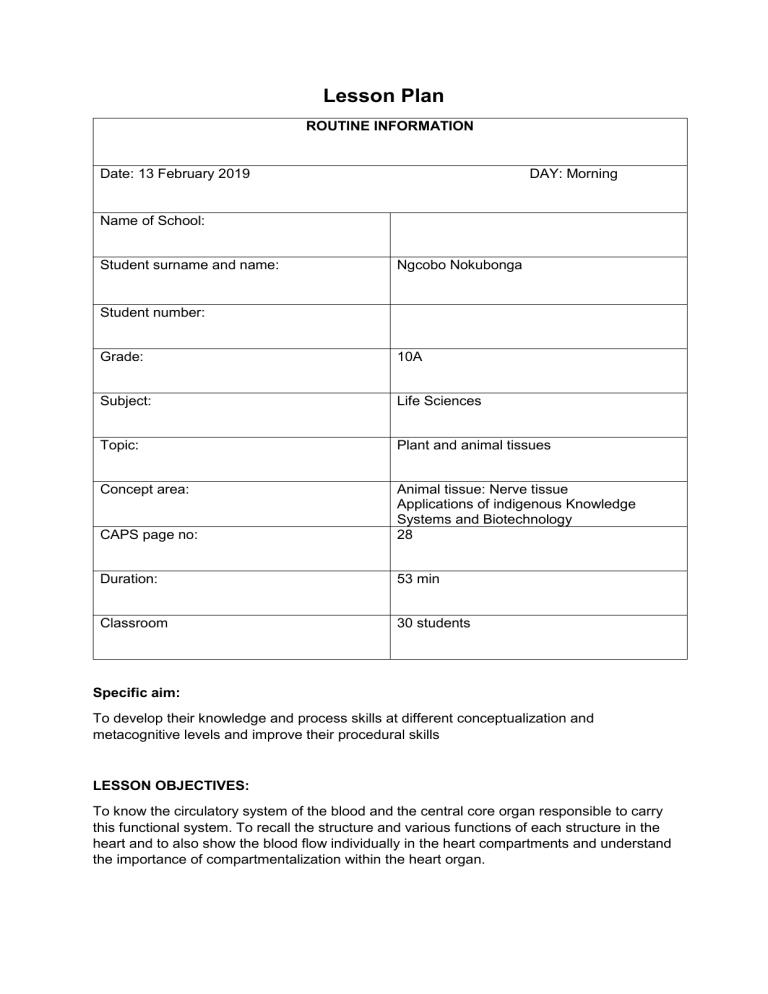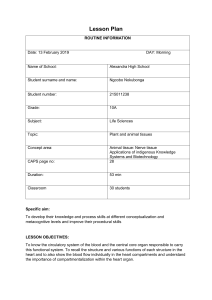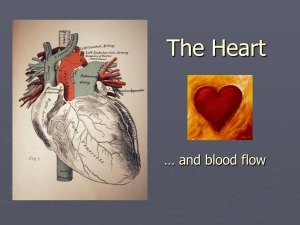
Lesson Plan ROUTINE INFORMATION Date: 13 February 2019 DAY: Morning Name of School: Student surname and name: Ngcobo Nokubonga Student number: Grade: 10A Subject: Life Sciences Topic: Plant and animal tissues Concept area: CAPS page no: Animal tissue: Nerve tissue Applications of indigenous Knowledge Systems and Biotechnology 28 Duration: 53 min Classroom 30 students Specific aim: To develop their knowledge and process skills at different conceptualization and metacognitive levels and improve their procedural skills LESSON OBJECTIVES: To know the circulatory system of the blood and the central core organ responsible to carry this functional system. To recall the structure and various functions of each structure in the heart and to also show the blood flow individually in the heart compartments and understand the importance of compartmentalization within the heart organ. SKILLS: Learners should be able to recognize the location of the heart and explain different parts of the heart through recalling the terms such as aorta, veins, arteries and valves. Through recalling the learner should be able to state the functions of that particular structure supported by the importance of such function. Also have the curiosity to collect more information about the heart and its role in circulation in-order to improve their individual logic based on the blood circulatory concept. VALUES: The learner should develop scientific attitude towards the basic and the scientific heart structure, and also show awareness regarding possible heart mal-functionality and predict what could be the cause based on the knowledge learnt. APPROACH/TEACHING METHOD Question and answer strategy/ individual work / group work RESOURCES: POWER POINT, Chalkboard and study guide INTRODUCTION: Learners will be asked to engage in the FEEL YOUR HEART BEAT action exercise on both their wrist temple of the left hand and the chest. One random learner to draw a heart emoji on the board. Have them imagine and think where the foetus obtains the blood from. Pose a question: what is the heart and where is it located? DEVELOPMENT: Step 1: Discuss what is the heart, where is it located and what is it’s function. Ask them what they felt and what was the purpose of the FEEL YOUR HEART BEAT exercise. Learners should respond orally and I will select and filter important and specific answers and write them on the board: Expected answers: - What is heart? The love location/ organ (that pumps blood) Location On the thoracic cavity/ behind the left lung/ rib cage. What is the heart’s function? Love/ pump blood/ facilitate nutrient distribution. Step 2: Tell them about the biological systems and biological processes. -Write on the board the organizational function Input ----- processing-----output/outcome relate it to everyday science such as food intake to obtain energy. Step 3: The blood circulatory system. Draw the heart chambers, show valves introduce the terminology of the structural organization step by step. Thereafter, show blood circulation: - on entry and on exit, relate to the contractions and relaxation to facilitate pumping. Define vein and artery, ask the difference between the two: Expected answers- (a) the direction they carry blood to/fro (b) types of bloods they carry deoxygenated/ oxygenated blood. Step 4 Having learnt about the heart structure and its function. The class is then organised in groups with where label their own heart structure provided in the worksheet which is a complete structure. From then any learner from a particular group is randomly selected to come and stick relevant explanation/label a particular heart structure/ the missing piece of the heart that is provided in the interactive chart. CONSOLIDATION: 1. 2. 3. 4. 5. Heart is located between the lungs inclinating to the left. The heart is the size of a person’s fist. It is conical in shape. Is lined by the outer fibrous tissue sac. It relaxes and contracts in milliseconds. ASSESMENT 1. Worksheet REFERENCES: 1. 2. 3. 4. CAPS Document for Life Sciences Textbook Syavula textbook Google images for the heart structure. Work sheet Date: __________________ Grade:_________ Name and surname: ________________ 1. Complete label the heart structure. (15) 2. (2) 3. In the structure figure no. 1, it is noticed that the left cardiac muscle is much bigger in size, discuss what the possible scientific reason behind this is.(5) 4. A patient with a non/little flexible tricuspid valve history, gets admitted to the hospital due to heart failure and stroke on the upper body part. Deduct what could be the possible issue regarding the overall heart system.(5) Model answer Work sheet Date: 02 February 2019 Grade: 10A Name and surname: Ngcobo Nokubonga 1. Complete label the heart structure. (15) 3. In the structure figure no. 1, it is noticed that the left cardiac muscle is much bigger in size, discuss what the possible scientific reason behind this is. Maintain pressure Pump blood up to the body and ensure distribution force, the push force Assist with the contraction and relaxation movements required to facilitate blood flow Support the functions of the semi-lunar valves since they operate in a one way flow, compared to the tricuspid valve. 4. A patient with a non/little flexible tricuspid valve history, gets admitted to the hospital due to heart failure and stroke on the upper body part. Deduct what could be the possible issue regarding the overall heart system. The is a right atrium tricuspid valve which allows flow of blood from vena-cava vein the to the right ventricle . When this valve does not open/close properly, this may result to huge amounts of blood flowing into the right ventricle which may result to expansion of the ventricle or no order in the right hand side of the heart and huge amounts of blood flowing to the lungs which may have an effect on the respiration rate thus resulting in a patient’s current condition. A stroke occurs when the blood supply to part of your brain is interrupted or reduced, depriving brain tissue of oxygen and nutrients. Within minutes, brain cells begin to die.

